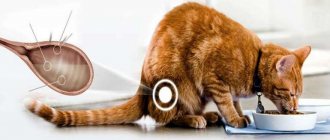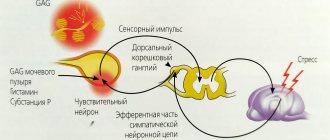With inflammation of the genitourinary system, urocystitis develops in cats. The disease is accompanied by difficulty and discomfort when urinating, and an increase in temperature. At the first symptoms, the owner is advised to take the pet to the veterinarian. The specialist will conduct a diagnosis, prescribe medications and herbal decoctions, and give preventive recommendations.
According to Estonian veterinarian Andrus Joost, cheap, low-quality food promotes the formation of crystals in the urine, which can trigger inflammatory processes in the genitourinary system.
Why does pathology occur?
Feline urocystitis is characterized by inflammation in the ureters and bladder. The disease can be primary, when inflammation begins immediately in the organs, and secondary, appearing against the background of other ailments - arthritis, urolithiasis, dermatitis. Most often, pathology occurs due to the activation of pathogenic microbes that enter the urinary structures through the bloodstream. They penetrate into the mucosal tissue, causing inflammation and frequent urination. These include:
- proteas;
- Klebsiella;
- staphylococcus;
- streptococcus;
- Pseudomonas aeruginosa;
- enterococcus
Prolonged exposure to cold may be the cause.
Main causes of inflammation:
- hypothermia;
- injuries;
- frequent constipation or diarrhea;
- bearing offspring and childbirth;
- benign or malignant tumors;
- decreased immunity;
- inflammatory process in the internal genital organs or rectum.
Disease prevention
To prevent the disease from returning to a still weakened animal, the owner must follow simple rules:
- Do not allow your pet to become hypothermic. There should be no drafts in the house. Don't let your four-legged dog lie on the cold floor. It is better to accustom him to a warm bed.
- Compose a complete, balanced diet wisely. If it is not possible to buy natural food, then give preference to premium dry food. There is nutrition for the prevention of urolithiasis.
- Get your vaccinations up to date and undergo routine checkups.
- Avoid hazardous situations. If they occur, a doctor's examination is required.
- Try to make your pet's life calm, well-fed, and with a minimum of stress.
- Don't forget about the need for clean water in your diet.
(Visited 2,523 times, 2 visits today)
Symptoms: how does the disease manifest itself?
The main sign of urocystitis in cats is difficulty passing urine, when the animal can sit on the tray for 20-30 minutes. The discharge is scanty, no more than 5 ml. The cat can also sit down on any part of the room, leaving wet spots. In addition, symptoms such as:
- the appearance of blood or mucus in the urine;
- hyperthermia;
- stiffness when moving;
- aggression and anger due to pain when trying to stroke the stomach;
- anxiety, restlessness;
- decreased appetite;
- involuntary loss of urine.
Urocystitis in cats
Author: Tatyana Zilskaya Category: Diseases and treatment
With urocystitis, an inflammatory process is observed that affects the mucous membrane of the bladder. Pathology can be superficial or deep. The development of catarrhal, purulent and putrefactive inflammation is possible. Causes of the disease
The main role in the development of cystitis in cats belongs to microbes and viruses.
Predisposing factors to this disease are pregnancy, childbirth, inflammatory lesions of the vagina, poisoning, exposure to too low temperatures, disruption of the digestive tract in the form of constipation and diarrhea. The bladder can become inflamed due to purulent mastitis, arthritis, dermatitis, etc. Chronic cystitis, as a rule, occurs as a result of tuberculosis, tumor processes, and urolithiasis. Pathogenesis
In the presence of good immunity, the bladder becomes inflamed relatively rarely.
The development of cystitis is based on a disorder of local blood circulation and the entry of a large number of pathogenic microbes into the bladder. The infection can enter the organ cavity through blood vessels. Inflammation causes pronounced contraction of the bladder. This promotes increased urination. The detection of blood cells, microorganisms, and epithelium in the urine is typical. As a rule, the causative agent of cystitis is staphylococcus, E. coli, etc. Clinical picture of the disease
In most cases, the development of inflammation of the bladder is sudden.
There is frequent painful urination. Mucus and blood are found in the urine. As the disease progresses, urinary incontinence may occur. This is due to the relaxation of the sphincter at the bladder neck. There is pain in the bladder area. The cat is depressed, restless, and moaning. The smell of urine becomes foul. Palpation reveals a full bladder. It is typical for sick animals to constantly lick the fur in the area of the pubic fusion. If the animal is trained to use the toilet, with cystitis it takes the learned position. This is accompanied by prolonged urinary retention and bladder overflow. As a result, pain and impaired urination occur. Diagnosis The
diagnosis of this disease is based on anamnestic data, clinical signs, results of urinalysis and fluoroscopic examination.
Urocystitis must be distinguished from pyelonephritis and urolithiasis. Treatment of the disease
First of all, elimination of the action of provoking factors is indicated.
It is recommended to regularly massage the bladder through the anterior wall of the abdomen and apply heat to the lumbar region. The animals are required to follow a diet. Owners should exclude spicy, salty and other harmful foods from the cat's diet. To reduce pain during bladder inflammation in cats, you can use perinephric and visceral blockade. To combat infection in cystitis, antibiotics are prescribed taking into account sensitivity, sulfonamides (etazol) and disinfectants. To strengthen the body, it is recommended to use strychnine nitrate, securinine, and magnesium sulfate. The use of various vitamins is also considered effective. We are talking about thiamine bromide, riboflavin, cyanocobalamin, etc. Prevention
To prevent the development of urocystitis in cats, it is necessary to optimize their living conditions, improve feeding and promptly treat injuries and infectious diseases.
- Urocystitis
- cats
- diseases
January 24, 2017| 17:39
2473 views
Treatment: which methods are effective?
Drug therapy
If treatment is not started in a timely manner, the disease can become purulent, leading to sepsis and death.
The doctor prescribes the medications and dosage; self-medication can cause the death of the cat. A sick animal should be provided with a calm environment and warmth. For the treatment of urocystitis, a complex of medications is used, shown in the table:
| Drug group | Name |
| Antispasmodics | "No-Shpa" |
| "Novocaine" | |
| Antibiotics | "Levomycetin" |
| "Amoxiclav" | |
| "Kanamycin" | |
| "Gentamicin" | |
| Antimicrobial | "Furadonin" |
| "Furazolin" | |
| "Furagin" | |
| Homeopathic | "Stop cystitis" |
| "Cyston" | |
| "Kotervin" | |
| "Kantaren" |
Phytotherapy
Herbal infusions are rarely to the animal's taste.
Along with medications, it is recommended to give a sick cat decoctions of diuretic herbs - horsetail, lingonberry leaves, knotweed, juniper fruits, bearberry. The animal should be given water through a syringe without a needle in small portions so that the cat does not choke. Preparation:
- Take 5 g of any plant, pour 200 ml of hot water.
- Leave for 30 minutes, cool to 30-35 degrees, filter.
- Drink 2-3 times. per day 10 ml.
Treatment of hemorrhagic cystitis
After diagnosis (examination, blood and urine tests, ultrasound, culture), the specialist confirms the diagnosis and prescribes therapeutic measures. Most often he prescribes medications:
1. Antibiotics . In most cases, aggressive methods cannot be avoided. They have many contraindications and side effects, but only they can completely kill bacteria. They are not prescribed without prior sensitivity testing. The safest for domestic predators are: Amoxicillin, Cobactan, Cefazolin. The dosage is calculated individually, depending on weight, age, examination results, existing restrictions and the patient’s condition.
2. Antispasmodics . They not only relieve pain, but also relax smooth muscles. This helps relieve the suffering the cat is experiencing. The most common: No-shpa, Papaverine, Platiphylline.
3. Uroseptics . They are required to relieve swelling and increase blood circulation. This promotes the complete excretion of urine, due to which the urinary tract is “cleansed” of bacteria. It is better to give preference to Furosemide, Gamavit, KotErvin. Madder extract is suitable for alternative medicine.
4. Pribiotics . Antibiotics negatively affect the intestinal microflora. Therefore, at the same time it is recommended to give your pet medications that eliminate their side effects. This is Bifitrilak, Enterol. When purchasing, pay attention to expiration dates and storage conditions.
5. Hemostatic agents (if necessary). A 10% calcium chloride solution is administered intramuscularly. This point should be of particular concern to cat owners. In this case, it is necessary to transport the pet to the veterinary clinic as soon as possible.
Prevention
To avoid feline urocystitis, it is recommended not to keep the cat in a draft or in a cold room. You should also protect the animal from injury. During pregnancy, you need to consult a veterinarian, following the doctor’s recommendations, and during childbirth, it is advisable to have a specialist present. Food should be chosen of high quality, age-appropriate and for the prevention of kidney and ureter diseases. All diseases of the genitourinary system must be cured in a timely manner, and chronic ailments must be kept in remission.
Symptoms and signs of hemorrhagic cystitis
If the owners did not pay attention to the cat’s anxiety in time, then the disease progresses. This is evidenced by blood in urine. This is where the hemorrhagic form begins. This is a reason to sound the alarm. Its reasons are:
- hypothermia;
- infections;
- weakened immunity;
- unbalanced diet;
- obesity and sedentary lifestyle;
- parasites;
- urolithiasis;
- pyelonephritis;
- congenital anomalies in the structure of the urethra;
- stress;
- injuries;
- chronic illnesses;
- lack of fluid.
In order not to miss this moment, it is important to know everything about cystitis and its signs. Most often they appear as:
- Screaming and restlessness during the day, especially when going to the litter box.
- Frequent (more than 3 times per hour) visits to the toilet. If you observe your pet at this time, you will see that literally a few drops of urine are released. At the end the cat cries pitifully.
- Increased thirst. Fluffy is attracted only to a saucer of water and refuses food. This is an attempt to replenish dehydration due to constant urination.
- Drowsiness, weakness, loss of appetite. The representative of the cat family sleeps almost all the time, shuddering and screaming at this time. He stops coming to the bowl and shows no interest in anything. The illness forces him to completely change his usual way of life.
- The pet is trying to attract attention. There are different ways to do this: from plaintive meowing to urinating on things or the sofa. The last action takes place demonstratively in front of people. If this is uncharacteristic for the cat and he was raised before.
- The chronic stage is manifested by an increase in urine volumes and sudden changes in its color and smell. In acute cases, mucus or blood and a putrid odor are observed.
- Painful sensations. It is unpleasant for your pet to try to stroke his belly. He scratches or runs away.
- Weakness of the hind legs. The male or females pull them along.
- Fever. This is one of the signs of intoxication.
Features of cystitis
Both male and female cats are susceptible to cystitis. But clinical manifestations in cats are much more common. This is due to anatomical features. In cats, the urethra is straight, short and wide, so salt crystals are excreted almost unhindered in the urine. In cats, the urethra is longer, has bends and narrowings, so mucus and salt plugs often appear in it, completely blocking the flow of urine (obstruction).
Neutered cats, whose genitourinary system functions differently than normal cats, are more prone to cystitis. In addition, stagnation of blood in the genitals leads to swelling, and this leads to spasms and urinary retention, stagnation in the bladder, salt loss, urolithiasis and chronic cystitis.
Sometimes, with cystitis, pets avoid using their litter box because they associate it with pain when urinating. And in some cases, the fear of the toilet remains even after complete recovery. Thus, cystitis can cause behavioral changes.











